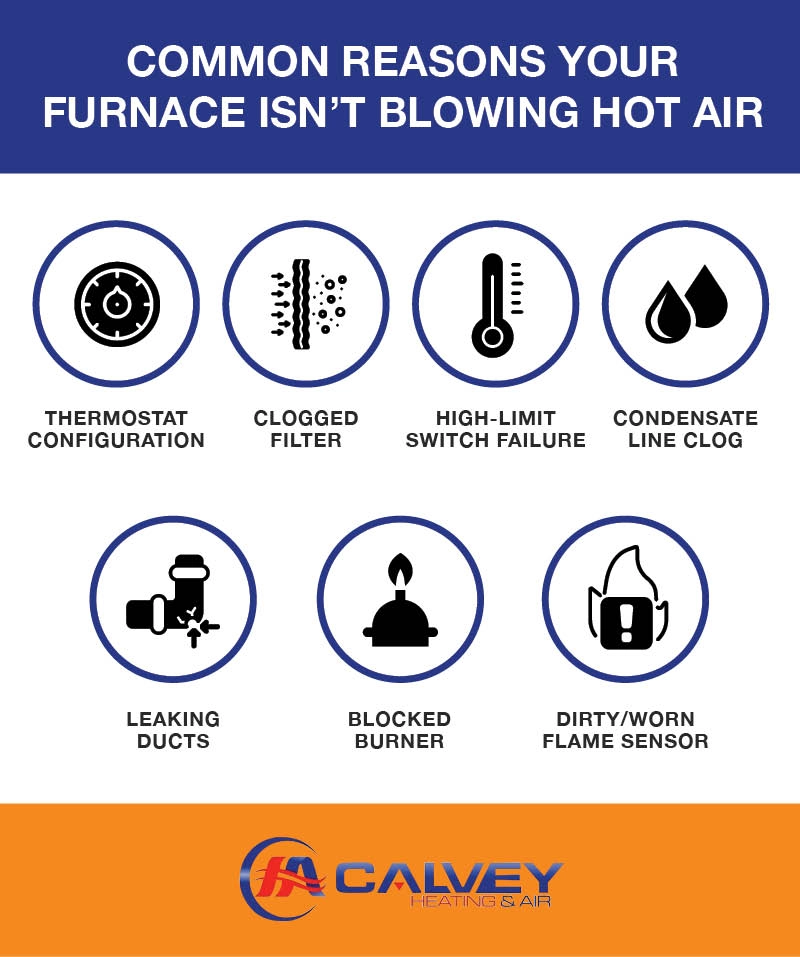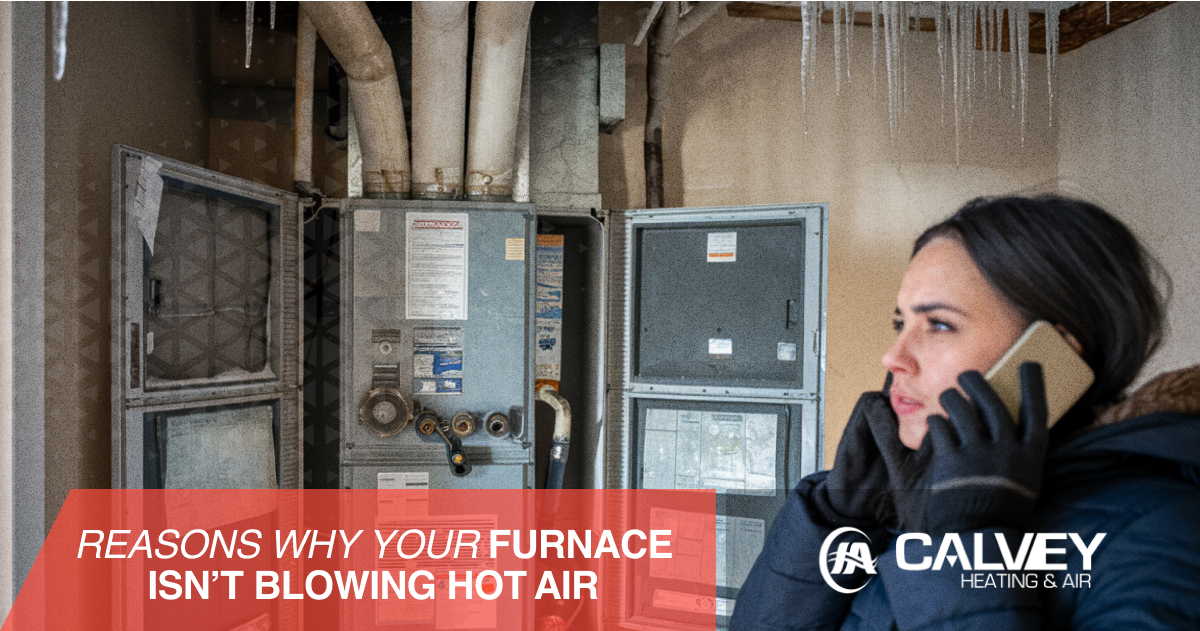There are many possible reasons your Northern California home’s furnace is not blowing hot air. A furnace is made up of several primary components, each with several smaller parts. When cold air is blowing from your heater, call the local experts at Calvey Heating & Air. We’re a family-owned business with years of experience in furnace maintenance, repair and installation in the Bay Area. We’ll have your furnace up and running in no time.

What To Do When Your Furnace Turns On but No Heat Is Produced
If your furnace turns on but no heat is coming through the vents, you can try this:
- Check the thermostat: Make sure it’s set to “heat” and the temperature is higher than the room temperature.
- Inspect the air filter: Replace the air filter if it’s dirty or clogged.
- Check the circuit breaker: Make sure the circuit breaker isn’t tripped and the fuse isn’t blown.
- Examine vents: The vents should be unobstructed.
- Check the pilot light: If you have a gas furnace, check the pilot light. It should be blue, not yellow or orange.
- Check the ignition system: If you have an electric furnace, make sure the ignition system is working.
If you follow these steps and there’s still cold air coming from your vents, contact the experts at Calvey. Our fully licensed, bonded, and insured technicians will quickly diagnose your furnace problem and get your home warm again.
Why Isn’t My Furnace Blowing Hot Air?
Here are some common causes of your furnace not blowing hot air and what can be done to solve the issue.
Thermostat configuration
The thermostat is the first thing you should examine if your furnace is blowing cold air. The thermostat’s fan setting might be set to “on,” causing the fan to constantly blow cold air. Set the fan to “auto” mode, and it will only turn on when the furnace generates heat.
If you have the type of thermostat that runs on a self-contained battery, it may need to be replaced. Also, sometimes DIY thermostat installations aren’t compatible with the existing HVAC system. When this happens, a Calvey technician will help you fix the problem.
Clogged filter
When your furnace filter clogs, it can cause cool air to circulate throughout your home. You can replace the filter yourself and try restarting the furnace. There may still be cold air in the ducts so it may run cold at first, but after a few minutes the air should warm up.
High-limit switch failure
A high-limit switch is a safety device that prevents your furnace from overheating. If your furnace gets too hot, it responds by turning on the fan to cool the system. When the high-limit switch malfunctions, you’re no longer dealing with a simple problem and will need to hire a Calvey HVAC professional to repair it.
Clogged condensate line
A condensate line drains water from the condensing unit. A blockage in the condensate line triggers a switch in the furnace, preventing the burners from starting, which can force cold air into your home. Calvey has specialized tools for cleaning these lines. After the lines are cleaned, Calvey can reset the system to get it working again.
Leaking air ducts
The ducts carry air from the furnace to the rest of your home, but they’re prone to leaks. Also, holes in your ducts can allow cold air into the system, which will then circulate throughout your home.
Blocked burner
Over time, burners can get blocked or clogged, preventing fuel from getting through. Without fuel, the burner won’t ignite, so the air doesn’t get heated. When this happens, your furnace circulates cold air instead of hot air.
Dirty or worn-out flame sensor
The burner will switch off due to a clogged or malfunctioning flame sensor, resulting in the furnace blowing cold air. If the sensor is dirty, cleaning it may solve the problem. However, if it’s broken, it will need to be replaced, which is a job best left to the Calvey professionals.
Keep Your Furnace Ready for Colder Months: Maintenance Tips
Keeping your furnace maintained avoids cold weather shutdowns and keeps your furnace running safely and efficiently.
Here is Calvey’s winter furnace checklist:
- Change your furnace air filter when it’s dirty.
- Change the thermostat batteries and reconfigure it if necessary.
- Schedule professional maintenance before the cold season.
- Clear the area around your furnace.
- Clean and check vents and registers for obstructions.
- Test carbon monoxide detectors and replace batteries if necessary.
When To Call a Professional for Furnace Issues
Blowing cold air is just one reason you might need to call a Calvey furnace professional. Here are some other signs your furnace needs professional service:
- Noises: You may hear some startup sounds, but your furnace should run almost silently, with background noise at most. If you hear strange or loud sounds, something is wrong.
- Thermostat issues: If you’re getting inaccurate readings or an error message, there may be a problem.
- Discolored pilot light: Your pilot light should burn almost entirely blue. If not, it could indicate an improper air mixture in your furnace or a ventilation issue. Both issues mean your furnace isn’t running as efficiently as it should, which could be a safety issue.
- Higher heating bills: You might see a steady increase or a dramatic spike in your bill.
- Burning smell: Dust or debris could be burning, particularly if you haven’t run your furnace recently, but that should dissipate quickly. If the smell persists, call Calvey.
Contact Calvey Today
Calvey Heating & Air is committed to flat-rate pricing, efficiency, and lasting customer relationships. If your central heater is not blowing hot air or you’re experiencing any HVAC issues, contact us and we’ll get the warm air flowing again.
Frequently Asked Questions
Why is my thermostat working but the heat is not coming on?
There are several reasons you might be experiencing this, including a malfunctioning thermostat, a dirty air filter, improper thermostat settings, a faulty flame sensor, a tripped circuit breaker, a blocked gas supply, or a wiring issue.
Why is my furnace not blowing hot air with full Freon™?
Freon™ is a brand that makes refrigerants for cooling systems and not related to your furnace.


